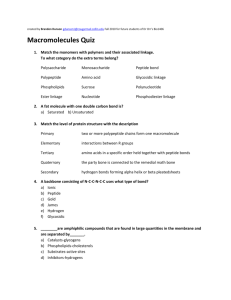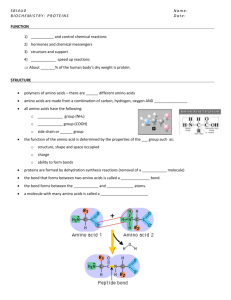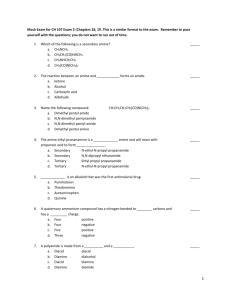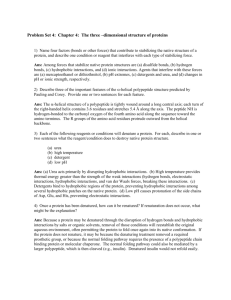What is a triacylglycerol?
advertisement
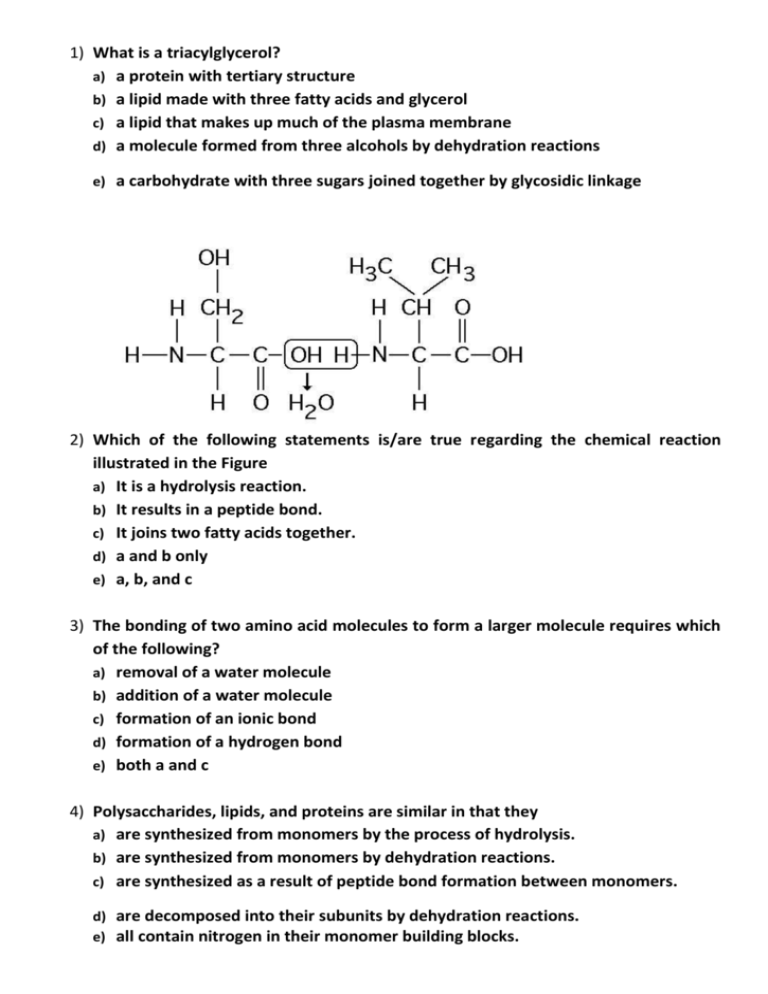
1) What is a triacylglycerol? a) a protein with tertiary structure b) a lipid made with three fatty acids and glycerol c) a lipid that makes up much of the plasma membrane d) a molecule formed from three alcohols by dehydration reactions e) a carbohydrate with three sugars joined together by glycosidic linkage 2) Which of the following statements is/are true regarding the chemical reaction illustrated in the Figure a) It is a hydrolysis reaction. b) It results in a peptide bond. c) It joins two fatty acids together. d) a and b only e) a, b, and c 3) The bonding of two amino acid molecules to form a larger molecule requires which of the following? a) removal of a water molecule b) addition of a water molecule c) formation of an ionic bond d) formation of a hydrogen bond e) both a and c 4) Polysaccharides, lipids, and proteins are similar in that they a) are synthesized from monomers by the process of hydrolysis. b) are synthesized from monomers by dehydration reactions. c) are synthesized as a result of peptide bond formation between monomers. d) are decomposed into their subunits by dehydration reactions. e) all contain nitrogen in their monomer building blocks. 5) Dehydration reactions are used in forming which of the following compounds? a) Triacylglycerides b) Polysaccharides c) Proteins d) a and c only e) a, b, and c 6) Upon chemical analysis, a particular polypeptide was found to contain 100 amino acids. How many peptide bonds are present in this protein? a) 101 b) 100 c) 99 d) 98 e) 97 7) At which bond would water need to be added to achieve hydrolysis of the peptide, back to its component amino acid? _________________ 8) Which bond is a peptide bond? ___________ 9) Which bond is closest to the carboxyl end of molecule? _____________________ 10) Which bonds are created during the formation of the primary structure of a protein? a) peptide bonds b) hydrogen bonds c) disulfide bonds d) phosphodiester bonds e) A, B, and C 11) a) b) c) d) e) 12) a) b) c) d) e) What maintains the secondary structure of a protein? peptide bonds hydrogen bonds disulfide bonds ionic bonds phosphodiester bonds The tertiary structure of a protein is the bonding together of several polypeptide chains by weak bonds. order in which amino acids are joined in a polypeptide chain. unique three-dimensional shape of the fully folded polypeptide. organization of a polypeptide chain into an α helix or β pleated sheet. overall protein structure resulting from the aggregation of two or more polypeptide subunits. 13) What would be an unexpected consequence of changing one amino acid in a protein consisting of 325 amino acids? a) The primary structure of the protein would be changed. b) The tertiary structure of the protein might be changed. c) The biological activity or function of the protein might be altered. d) Only a and c are correct. e) a, b, and c are correct. 14) a) b) c) d) Why glucose is the common sugar in the body? because it is the only monosaccharide. because all types of disaccharide are broken down to glucose because glucose is the milk sugar. because glucose is the malt sugar




